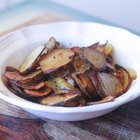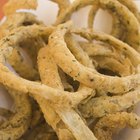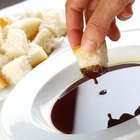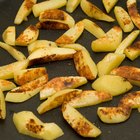
Your mother might be interested to know that, according to the United States Department of Agriculture, French fries are classified as vegetables. The type of oil the spuds are fried in contributes to their texture, flavor and nutritional value. While you can fry potatoes in a number of different oils, for the best flavor with the least amount of harmful by-products, most cooks lean towards frying in vegetable oil, although olive oil has its benefits.
Frying a Better Fry
When discussing which oil is "better" to use in frying French fries, two schools of thought often arise. One school tends to discuss the culinary aspects of flavor, texture, mouth feel and visual appeal, while the other school tends towards discussions about calorie count, fat content and nutritional value. Olive oil tends to have a higher nutritional content while vegetable oil produces a lighter, crispier fried food.
Olive Oil: Not Just Popeye's Sweetie Anymore
Olive oil is a monounsaturated fat that comes from expelling the oil from the fruit of the olive tree. According to the International Olive Council, olive oil is very stable and does not easily degrade when heated to high temperatures, making it ideal for frying food. Because of its high oleic acid content, it maintains its nutritional value better than other oils even when heated to high temperatures. Its "smoke point" -- the temperature at which the oil begins to smoke and form toxic products -- is 410 degrees Fahrenheit. French fries cook at 350 F.
Because the thinly sliced strings of potatoes need room to move in the hot oil, frying in olive oil can be costly. The aromatic oil can run from 47 cents per ounce to more than $2.50 per ounce, as of the time of publication. Olive oil can also impart a flavor of its own as the oil soaks into the potato during cooking. If you choose to fry in olive oil, choose the lightest oil, since the high temperature will eliminate most of the alcohols and esters that contribute to its robust flavor anyway.
Peanuts and Soybeans and Corn -- Oh, My!
McDonald's -- arguably the world's leading producer of French fries -- uses a canola blend to fry their famous sides. Lagasse cooks his golden strips in peanut oil. Vegetable oils, such as corn, peanut, soybean and canola, can withstand temperatures as high as 485 F. Because of their fluidity, light vegetable oils such as soybean oil produce a lighter fried food with a less greasy consistency. Vegetable oils don't contain the antioxidants that olive oil does.
Fry, Baby, Fry
The difference between a limp, soggy fry and a light, crisp one has a lot to do with temperature. Soaking the precooked potatoes in ice water and ensuring the oil is hot enough -- usually between 350 and 375 F -- helps prevent the absorption of too much oil during deep-frying. The hot oil heats the moisture in the potato to create internal steam, which creates the optimal pressure to prevent the oil from soaking the spud. The result is a light fluffy potato with a crunchy golden crust.
Related Articles

How to Remove Tanning Oil

Which Olive Oil Is Best to Fry With?

Cooking Oils With Low Smell

What Is Oil Blanching?

How to Fry Potatoes on the Stove

Can You Fry a Yukon Gold Potato?

What Is the Best Potato for Frying?

Canola Oil Vs. Lard in Baking

Substitutes for Groundnut Oil in Cooking

What Kind of Oil Should I Use to ...

How to Deep Fry Vegetables With Batters

Do Potatoes Go Bad When They Freeze?

The Shelf Life of Pumpkin Seed Oil

How to Cook French-Fried Turnips

The Best Potatoes For Shredded Hash ...

Does Deep-Frying Vegetables Rob Them of ...

How to Sautee Potatoes

How to Make a Foil Wrapped Potato

Sesame & Peanut Oil for Cooking

What is Rapeseed Oil?
References
Writer Bio
When not working in her family-owned food and bar business, Viola Horne can almost always be found with a cookbook in one hand and a whisk in the other. Horne never tires of entertaining family and friends with both comfort food and unusual delicacies such as garlic cheese smashed potatoes and banana bacon pancakes.
Photo Credits
Jupiterimages/liquidlibrary/Getty Images